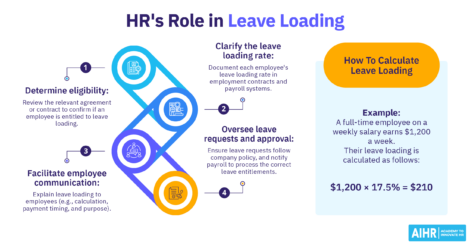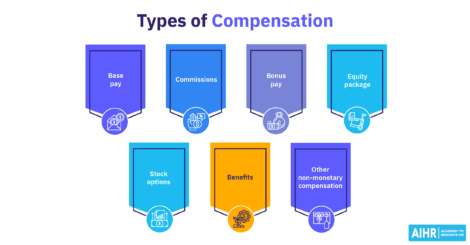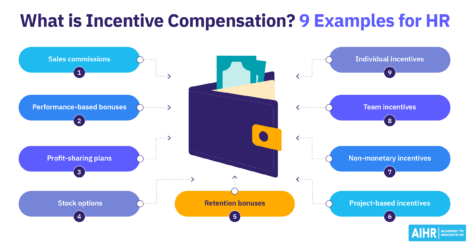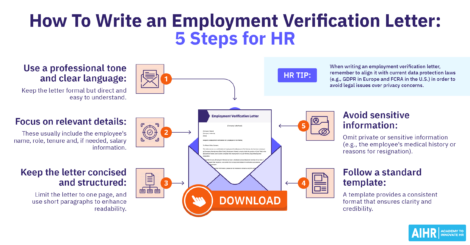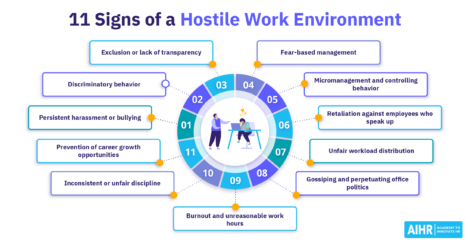How To Create Your Total Compensation Statement Template [FREE Download]
Pre-2020, less than a third of organizations had a compensation strategy. Today, most recognize its importance. But without a total compensation statement, do your employees know what their total packages include? It’s time to turn this document into a tool for loyalty and retention.

What if a total compensation statement template could transform the way your organization communicates value to employees? Imagine increasing transparency, boosting engagement, aligning individual contributions with organizational goals, and reinforcing your company’s commitment to fairness and recognition. Sound like a game-changer? It is.
A thoughtfully designed total compensation statement template gives employees a clear, comprehensive view of their rewards, helping you attract and retain top talent while promoting a culture of appreciation.
Contents
What is a total compensation statement?
The benefits of having a total compensation statement
What to include in a total compensation statement template
How to create a good total compensation statement
Free total compensation statement template
What is a total compensation statement?
A total compensation statement is a detailed summary of an employee’s compensation package beyond their base salary. It outlines all the financial and employer-paid benefits an employee receives, including bonuses, incentives, retirement contributions, health insurance, paid time off, and other perks like wellness programs or tuition reimbursement.
It’s an effective tool for communicating the full value of employment to employees, helping them understand the true financial worth of their compensation package.
Compensation remains the top priority for job seekers, with higher pay being the leading reason U.S. workers aged 25-54 search for a new job. Organizations must offer competitive pay and rethink how they structure and present their total compensation and benefits packages to bring in and retain top talent.
Sometimes, the terms total compensation statement and total rewards statement are used interchangeably, but there is a slight difference.
A total compensation statement aims to demonstrate the full financial value of employment, while a total rewards statement focuses on showcasing the overall value proposition and employee experience. As such, it would also include elements like career growth, recognition, and culture.
The benefits of having a total compensation statement
As an HR professional, total compensation statements are a strategic resource that can help you improve transparency and enhance employee engagement. They can be used during performance reviews, onboarding, or retention conversations to demonstrate the organization’s commitment to employees and to highlight the competitive advantages of the company’s offerings.
For organizations, total compensation statements are a strategic asset to boost retention, attract talent, and maximize the use of offered benefits. For employees, they provide a holistic understanding of their compensation, empowering them to make informed financial and career choices.
Let’s take a look at the key reasons why your organization should use total compensation statements and how this will benefit employees.
As an organization, use total compensation statements to:
- Improve engagement and retention by demonstrating the organization’s investment in employees, increasing satisfaction and loyalty
- Support career growth discussions through a foundation for meaningful conversations about career progression and compensation
- Enhance transparency and build trust by clearly outlining all components of the employee’s compensation package
- Attract talent through a tool that showcases the organization’s competitive benefits during recruitment
- Promote benefit utilization by identifying and highlighting underutilized benefits, ensuring employees take full advantage of available resources.
Educate employees on how they can use total compensation statements to:
- Boost their financial planning through a clearer view of total earnings
- Make better use of their benefits because they understand what’s available to them
- Gain a comprehensive overview of rewards, which can aid in career planning and job satisfaction
- See the full value of their compensation, which enhances their perception of the organization’s support and ultimately increases appreciation
- Make informed choices about their financial future through a better understanding of retirement contributions and health plans.
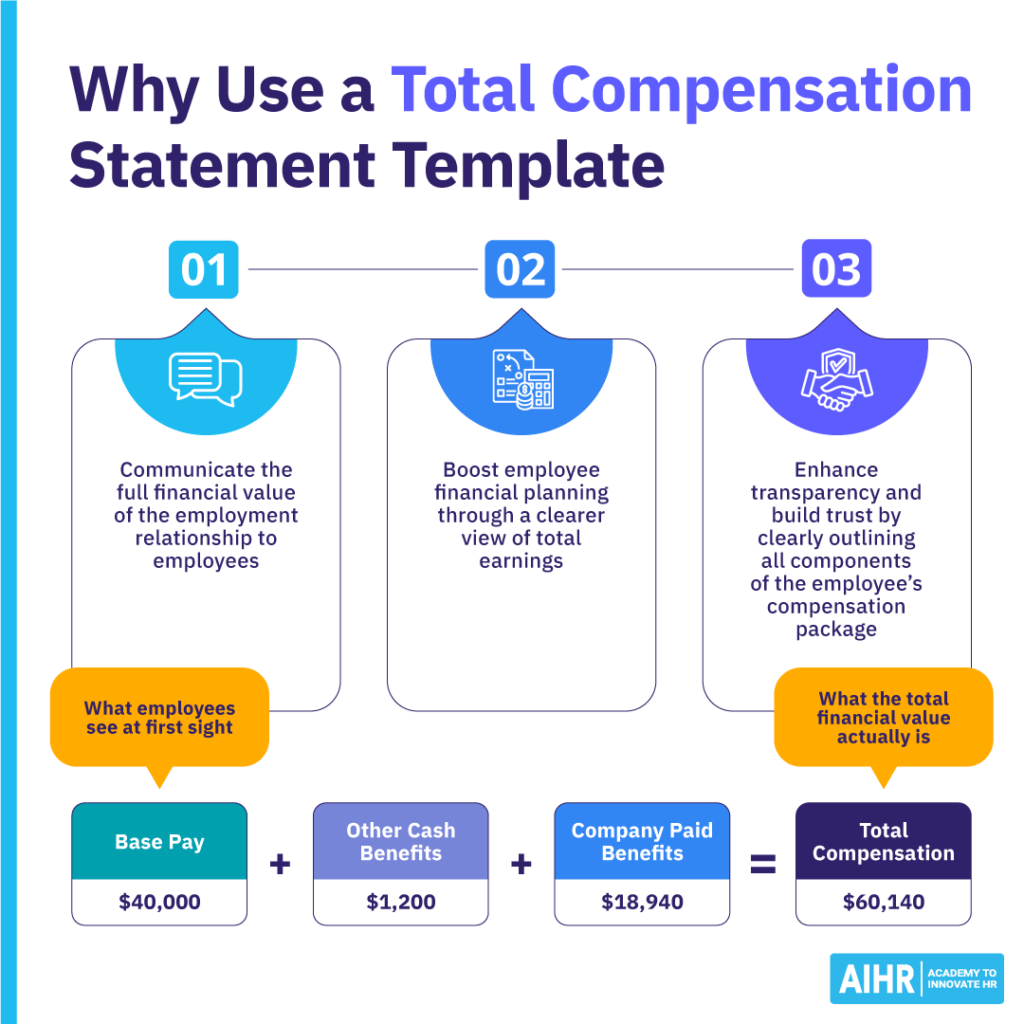
What to include in a total compensation statement template
Creating an effective total compensation statement is about more than listing numbers like base salaries, overtime, and 401(k) contributions. A great total compensation statement should be detailed, clear, and tailored to the needs of both employees and organizations.
Here are the key sections that your template should include.
1. Basic information
- Employee’s name and job title
- Statement period (e.g., annual, semi-annual, or monthly)
- Company name and contact information for HR or benefits queries.
→ Do this: Use clear formatting and ensure the time period covered is prominently highlighted. Tailor the statement to align with payroll cycles for consistency and avoid confusion about when the compensation applies.
2. Direct compensation
- Base salary or hourly wages
- Bonuses, commissions, or other performance-based incentives
- Overtime pay (if applicable).
→ Do this: Break down direct compensation into categories to show transparency. This includes year-to-date totals and projections, where possible, to help employees see the bigger picture of their earnings.
Pay remains the number one motivation for employees to stay at their jobs, so it’s important to make it stand out in the compensation statement. This is followed by job security (41%), health benefits (36%), and flexible work arrangements (31%).
Learn how to attract and retain employees through total compensation
A well-crafted total compensation statement helps employees see the full value of their rewards—beyond just salary. But are you designing yours strategically?
AIHR’s self-paced Compensation & Benefits Certificate Program helps you master the skills to build competitive, transparent, and equitable compensation structures that attract and retain top talent. Learn how to optimize salary, benefits, and incentives to drive employee engagement and business success.
3. Indirect compensation
- Health, dental, and vision insurance premiums paid by the company
- Life insurance, disability insurance, and other coverage
- Wellness programs or Employee Assistance Programs (EAPs).
→ Do this: Use visuals like pie charts to illustrate the company-paid portion of benefits. This makes it easier for employees to see the value they’re receiving beyond their paycheck.
88% of employers in the U.S. rank health-related benefits as the most important benefit category
With health insurance being a standard offering for most organizations, employers are differentiating themselves in a competitive job market by expanding into innovative health benefits.
Health savings accounts (HSAs) remain popular in addition to programs like employee assistance, mental health coverage, and telemedicine. Employers are increasingly addressing bodily autonomy and personal benefits, introducing options like menopause counseling and gender-affirming hormone therapy, reflecting a broader commitment to employee wellbeing.
4. Paid time off (PTO)
- Total days or hours allocated for vacation, sick leave, and personal days
- Unused PTO carried over (if applicable) and its dollar equivalent
- Additional time off, such as holidays, parental leave, or volunteer days.
→ Do this: Include a breakdown showing the dollar value of unused PTO, emphasizing its role as part of the total compensation package.
Employers rate leave benefits as one of the top three most valued benefit categories, with a growing emphasis on mental health leave, personal time off, and family leave to meet employee expectations.
Forward-thinking organizations are staying ahead by offering innovative options like floating holidays, menopause leave, and time off to care for grandchildren. If you offer any of these types of leave, showcase that in your template.
5. Retirement benefits
- Employer contributions to 401(k) or pension plans, expressed in dollar terms
- Details of matching contributions, including thresholds for maximizing the match
- Vesting schedule and details on how much is accessible based on tenure.
→ Do this: Create a ‘retirement snapshot’ that projects potential savings in one, five, or 10 years with employer contributions. Include a side-by-side comparison of scenarios with and without employee contributions to encourage participation and showcase the significant value these benefits deliver to employees by supporting their long-term financial security.
6. Perks and other benefits
- Discounts on services like fitness memberships, childcare, or meal delivery
- Professional development reimbursements (e.g., certifications or tuition)
- On-site perks like free meals, parking, or wellness programs.
→ Do this: Include a “Did You Know?” section to highlight lesser-known perks and provide actionable steps or links to access these benefits, ensuring employees can easily take advantage of them.
7. Other monetary benefits
- Employee stock options or equity shares
- Commuter allowances or transportation reimbursements
- Relocation or signing bonuses.
→ Do this: Use a separate section to highlight one-time or periodic benefits like bonuses, making them stand out. Provide a brief explanation of eligibility criteria to add clarity.
8. Employer-paid taxes and contributions
- Social Security contributions
- Medicare taxes
- Unemployment insurance premiums and workers’ compensation.
Do this: Present this information in a straightforward table format. Align the time period (e.g., annual or monthly) with payroll cycles and include totals to make it clear how these contributions benefit the employee.
9. Career development opportunities
- Training and certification programs covered or subsidized by the employer
- Access to online learning platforms (e.g., LinkedIn Learning)
- Tuition reimbursement programs.
→ Do this: Showcase potential savings by comparing the cost of external training with the amount covered by the organization, helping employees see the value of career development support.
Ensure that your total compensation statement is aligned with what you promise in your EVP. These elements become the proof points of your EVP internally, showing employees how you deliver on the promises made. Misalignment here could lead to distrust and disappointment but also signal missed opportunities to refine your total compensation statement.

11. Flexible work benefits
- Remote work allowances or stipends for home office equipment
- Reimbursement for co-working spaces.
→ Do this: If offering remote or hybrid work perks, include a dollar estimate of savings (e.g., commuting costs avoided) to make the benefit tangible.
12. Recognition and rewards
- Monetary rewards, such as gift cards or spot bonuses
- Opportunities to earn points or credits for company-specific rewards.
→ Do this: Highlight any formal recognition programs and specify the monetary value or financial benefits offered. For example, include details like the average value of gift cards or bonuses distributed or the potential financial impact of point-based reward systems.
Sample total compensation plan
Summary of your total compensation
Direct compensation3
$90,000
Indirect compensation
$10,000
Retirement benefits
$4,250
Paid time off (PTO)
$9,807
Perks and other benefits
$4,100
Other monetary benefits
$3,000
Employer taxes and contributions
$7,623
Grand total compensation
$128,780
Next steps
We are committed to supporting your financial, professional, and personal wellbeing. If you have any questions about this plan or would like to make adjustments, please contact (HR contact name) at (email) or (phone).
How to create a good total compensation statement
Adopting best practices ensures that your total compensation statement is informative and a reflection of your organization’s commitment to its workforce.
- Keep it simple and clear: Use straightforward language to explain compensation components. Avoid jargon or overly technical terms that could confuse employees.
- Personalization matters: Address the statement to the employee by name. Reference their specific role, contributions, or achievements to make the statement feel tailored and relevant.
- Be transparent: Clearly explain how each component of the compensation package was determined (e.g., market benchmarks, performance metrics). Break down each benefit and its value to enhance understanding and build trust.
- Use visual aids: Incorporate charts, graphs, or infographics to represent data visually. For example, use a pie chart to illustrate the proportion of direct and indirect compensation or a bar graph to show year-over-year changes.
- Highlight tax advantages: Show how certain benefits, such as retirement contributions or healthcare plans, reduce taxable income. Include examples or scenarios to demonstrate the real value of tax-advantaged benefits.
- Educate employees: Provide a glossary or FAQ section explaining terms like ‘vesting,’ ‘equity,’ ‘matching contributions,’ and ‘pre-tax benefits.’ Include links or resources for employees to learn more about their benefits or take action, such as enrolling in retirement plans.
- Update regularly: Issue total compensation statements annually to reflect the most current information. Provide updated statements whenever there are significant changes, such as promotions, role changes, or adjustments to benefit plans.
- Focus on the full value: Emphasize the total value of compensation, not just salary. Include less visible benefits like employer-paid taxes and professional development opportunities.
- Make it accessible: Deliver statements in both digital and print formats to accommodate employee preferences. Use employee self-service portals for easy access and updates.
- Ensure data accuracy: Double-check all figures and details to avoid errors that could undermine trust. Work closely with payroll and benefits teams to ensure consistency.
- Customize for audience needs: Tailor the tone and format to the workforce. For example, younger employees might appreciate more details about student loan repayment programs, while senior employees may focus on retirement benefits.
- Include a call to action: Encourage employees to take the next step, such as increasing 401(k) contributions, enrolling in underutilized benefits, or attending HR-led informational sessions.
- Solicit feedback: Regularly gather employee feedback on the usefulness and clarity of the statement. Adjust the format and content as needed to address concerns and improve effectiveness.
Free total compensation statement template
Use a pre-developed total compensation statement template to make sure your organization has a clear and structured way to showcase the company’s investment in its employees.
Templates make the entire process simpler, smoother, and more consistent – which is a win for improving transparency and trust.
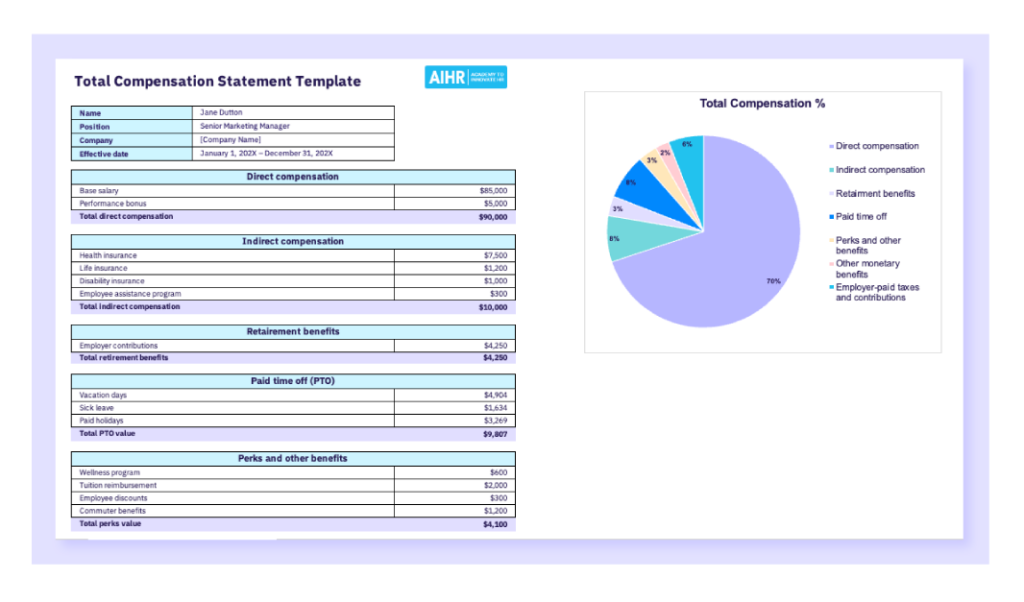
To sum up
Most organizations today have total compensation strategies in place. However, without a total compensation statement, employees are not aware of their full benefits. It’s a small upfront investment for HR professionals with a large return in terms of transparency, building trust, and driving loyalty.
As an HR professional, invest time upfront in developing a total compensation statement based on a proven template and best practices to align your compensation strategy with your organizational goals.
These documents play a critical role in career growth discussions, promoting benefit utilization and aiding in financial planning. By presenting data clearly and comprehensively, HR professionals can emphasize the full value of employment beyond just the direct compensation.
Learn more
Related articles
Are you ready for the future of HR?
Learn modern and relevant HR skills, online







